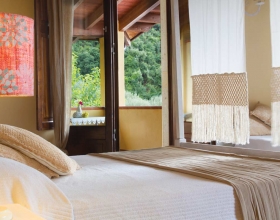Antica Tindari is situated in an area of great tourist and archaeological attraction
TYNDARIS
Tyndaris was situated on a bold and lofty hill standing out as a promontory into the spacious bay of the Tyrrhenian Sea bounded by the Punta di Milazzo on the east, and the Capo Calavà on the west.
By the 19th century, the site of Tyndaris was wholly deserted, but the name was retained by a church, which crowned the most elevated point of the hill on which the city formerly stood, and was still called the Madonna di Tindari. It is c. 180 m above the sea-level, and forms a conspicuous landmark to sailors. Considerable ruins of the ancient city, are also visible. It occupied the whole plateau or summit of the hill, and the remains of the ancient walls may be traced, at intervals, all round the brow of the cliffs, except in one part, facing the sea, where the cliff is now quite precipitous. The chief monuments, of which the ruins are still extant within the circuit of the walls, are: the theatre, of which the remains are in imperfect condition, but sufficient to show that it was not of large size, and apparently of Roman construction, or at least, like that of Tauromenium, rebuilt in Roman times upon the Greek foundations; a large edifice with two handsome stone arches, commonly called a Gymnasium, but the real purpose of which is very difficult to determine; several other edifices of Roman times, but of wholly uncertain character, a mosaic pavement, and some Roman tombs.The Black Madonna of Tindari, with the inscription NIGRA SUM SED FORMOSA, numerous others inscription, fragments of sculpture, and architectural decorations, as well as coins, vases, etc. have also been discovered on the site.
Inside the church is an effigy of the "Black Madonna", a wooden sculpture perhaps from Syria or Egypt, where it was carved around the 12th century.The sanctuary is situated at the eastern end of the promontory, overlooking the sea at the ancient acropolis, where a small church was built on the ruins of the abandoned town. The church was destroyed in 1544 by Algerian pirates, then rebuilt between 1552 and 1598. The sanctuary was more recently rebuilt again.
ANCIENT THEATRE
Another major monument in Tindari is the theatre, built in Greek times between the end of the 4th and 3rd centuries BC, which could hold about 3,000 people.Originally the arena was surrounded by a high podium, which may have reached 2.5 meters in order to protect the public from the dangers of the gladiatorial ludi (“games”).At the edge of the orchestra there is a stage of Hellenistic origin, with a diameter of about 18 meters. The façade, 12 meters high, was decorated with three rows of statues and Doric columns, as shown by the model presented in the Museum.
MARINELLO LAGOON
Local legend tells that the lagoon was created after a pilgrim who came to see the Madonna refused to pray to the Madonna because she was black. The woman accidentally dropped her baby into the ocean and the Madonna made the land rise to save the baby. The sands of Marinello have taken shape of the profile of the Madonna.
AEOLIAN ISLANDS
Aeolian Islands are seven islands in the Tyrrhenian sea in the province of Messina, all of volcanic origin: Alicudi, Filicudi, Panarea, Stromboli, Salina, Lipari and Volcano, the nearest island to Patti.
The Aeolian Islands in Italian Isole Eolie, are a volcanic archipelago in the Tyrrhenian Sea north of Sicily. They are a popular tourist destination in the summer, and attract a lot of visitors annually. The largest island is Lipari, the other islands each one different from the others include Volcano famous for its fango (mud) baths, Salina, Stromboli with a still active volcano, Filicudi, Alicudi, Panarea and Basiluzzo. The atmosphere in the islans is nonetheless universally wonderful. However, quite apart from the amazing scenery, history, culture, and climate, the islands also offer a whole host of more specific attractions to suit every taste. There are no cars and no city noises, you can feel apart from the real world, in some cases only recently was brought electricity.There are frequent car ferries and much quicker hydrofoils from Milazzo half an hour away from Patti. Most call first at Lipari, and then proceed to the other islands. Ferries are frequent but the Aeolian Islands are quite remote, which is part of their appeal. No air travel is available to the archipelago.
CAPO CALAVÀ BEACH
This long, narrow stretch of sandy beach lies between two tall rocky outcroppings that meet behind the beach, one of the most beautiful of all north Sicily. Visitors access the location on foot via steep paths through the hills. The beachfront consists of a combination of sand and fine pebbles. The water is sky blue and clear and perfect for swimming or snorkeling. The landscape that surrounds the area is very picturesque.Particularly suggestive is sunset time because unlike the Gulf of Patti, once you exceed the tip of Cape Calavà the sun sets over the stunning Tyrrhenian Sea.
SANTO STEFANO DI CAMASTRA
Santo Stefano di Camastra, one hour away from Patti, is a very famous center for hand-painted ceramics, along the main street there are countless workshops where to buy artifacts and gifts and admire the craftsmen working.Near Santo Stefano you can find La Fiumara dell’Arte, this remarkable project, is a sort of open-air museum, displaying contemporary sculpture all along the Tusa stream. Leave Santo Stefano di Camastra and follow the SS 113 towards Palermo. Throughout the entire route leading up into the Nebrodi, you can enjoy stunning panoramic views. The town is still part of Nebrodi Park.











